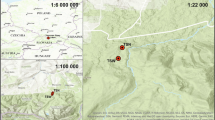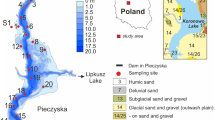Abstract
The aim of this study was to determine the level of radionuclide concentration in sediment cores in two different water ecosystems; one closed and one open. Based on this data the changes in these ecosystems were interpreted. Two sediment cores from the Dobczyce reservoir and the Smreczynski Staw Lake were collected and divided into 1 cm thick sub-samples. The samples were air dried and homogenized. The 137Cs and 210Pb (210Pbsup, 210Pbtotal, 210Pbuns) concentrations were measured using gamma and alpha spectrometry. Results showed that the 137Cs concentration in the Dobczyce reservoir is lower than in the Smreczynski Staw Lake. Total 210Pb concentration in the Dobczyce reservoir was around 70 Bq kg−1 and in the Smreczynski Staw Lake was about 500 or 1,200 Bq kg−1 with the decreasing tendency in the sediment core. Sediments are very important constituents of water ecosystems. In spite of the young age of the Dobczyce reservoir, the 137Cs and 210Pb radionuclides were very useful in understanding of the processes which have taken place in these ecosystems. The estimated sedimentation rate indicated such processes as regular sedimentation, mixing of sediments or floods. In the Smreczynski Staw Lake the changes have reflected the changes which took place in the Tatra Mountains.







Similar content being viewed by others
References
Saxena DP, Joos P, van Grieken R, Subramanian V (2002) Sedimentation rate of the floodplain sediments of the Yamuna river basin (tributary of the river Ganges, India) by using 210Pb and 137Cs techniques. J Radioanal Nucl Chem 251(3):399–408
Ajay K, Rupali K, Sabyasachi R, Vikram J, Rakesh KS, Pazhayath MR (2013) Spatial distribution and accumulation of 226Ra, 228Ra, 40K and 137Cs in bottom sediments of Mumbai Harbour Bay. J Radioanal Nucl Chem 295:835–839
Ritchie JC, McHenry JR (1990) Application of radioactive fallout cesium-137 for measuring soil erosion and sediment accumulation rates and patterns: a review. J Environ Qual 19:215–233
Yao S, Li S, Zhang H (2008) 210Pb and 137Cs dating of sediments from Zigetang Lake. Tibetan Plateau. J Radioanal Nucl Chem 278(1):55–58
Starmach J, Mazurkiewicz–Boron G (2000) Dobczyce Reservoir ecology–eutrofization–protection. Department of biology Karol Starmach PAN, Cracow
Sawicki L (1929) Tatra lake atlas. PAU, Cracow
Nowacki Ł (2006) Glacial and glaciofluvial form. Geol Rev 54(7):605–609
Ziemonska Z (1966) Water circulation in the mountain the example of upper basin Czarny Dunajec. Geographical work no 55, Warsaw
Golas J, Kubica B, Reczynski W, Kwiatek W, Jakubowska M, Skiba M, Stobinski M, Dutkiewicz EM, Posmyk G, Jones KW, Olko M, Gorecki J (2005) Preliminary studies of sediments from the dobczyce drinking water reservoir. Pol J Environ Stud 14(5):577–584
Szarlowicz K, Reczynski W, Kubica B, Golas J, Koscielniak P, Skiba M (2011) Sorption of 137Cs and Pb on sediment samples from the Dobczyce drinking water reservoir (south Poland). Pol J Environ Stud 20(5):1305–1312
Flynn WW (1968) The determination of low levels of polonium-210 in environmental materials. Anal Chim Acta 43:221–227
Henricsson F, Ranebo Y, Holm E, Roos P (2011) Aspects of the analysis of 210Po. J Environ Radioac 102:415–419
Sanchez–Cabeza JA, Masqué P, Ani-Ragolta I (1998) 210Pb and 210Po analysis in sediments and soils by microwave acid digestion. J Radioanal Nucl Chem 227:19–22
Wen X, Wu L, Zhang Y, Chu Y (1997) Optimized microwave preparation procedure for the elemental analysis of aquatic sediment, Fresenius’. J Anal Chem 357:1111–1115
Gelen A, Soto J, Gómez J, Díaz O (2004) Sediment dating of Santander Bay, Spain. J Radioanal Nucl Chem 261(2):437–441
Vesterbacka P, Klemola S, Salahel-Din K, Saman M (2009) Comparison of analytical methods used to determine 235U, 238U and 210Pb from sediment samples by alpha, beta and gamma spectrometry. J Radioanal Nucl Chem 281:441–448
Bloesch J, Evans RD (1982) 210Pb dating of sediments compared with accumulation rates estimated by natural markers and measured with sediment traps. Hydrobiologia 92:579–586
Sikorski J, Bluszcz A (2003) Testing applicability of 210Pb method to date sediments of human-made Lake Kozłowa Góra. Geochronometria 22:63–66
Sikorski J, Bluszcz A (2008) Application of α and γ spectrometry in the 210Pb method to model sedimentation in artificial retention reservoir. Geochronometria 31:65–75
Appleby PG, Piliposian GT (2006) Radiometric dating of sediment records from mountains lakes in the Tatra Mountains. Biologia Bratislava 18:51–64
Reilly JO, Vintro LL, Mitchell PJ, Donohue I, Leira M, Hobbs W, Irvine K (2011) 210Pb-dating of a lake sediment core from Lough Carra (Co. Mayo, western Ireland): use of paleolimnological data for chronology validation below the 210Pb dating horizon. J Environ Radioact 102(5):495–499
Szarlowicz K, Reczynski W, Misiak R, Kubica B (2013) Radionuclides and heavy metal concentrations as complementary tools for studying the impact of industrialization on the environment. J Radioanal Nucl Chem 298(2):1323–1333
Kotarba A, Łokas E, Wachniew P (2002) 210Pb dating of young halocene sediments in high-mountains lakes of the tatra mountains. Geochronometria 21:73–77
Author information
Authors and Affiliations
Corresponding author
Rights and permissions
About this article
Cite this article
Szarlowicz, K., Kubica, B. 137Cs and 210Pb radionuclides in open and closed water ecosystems. J Radioanal Nucl Chem 299, 1321–1328 (2014). https://doi.org/10.1007/s10967-013-2864-5
Received:
Published:
Issue Date:
DOI: https://doi.org/10.1007/s10967-013-2864-5




